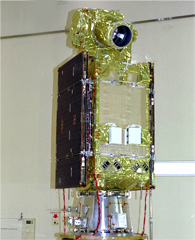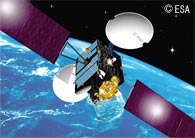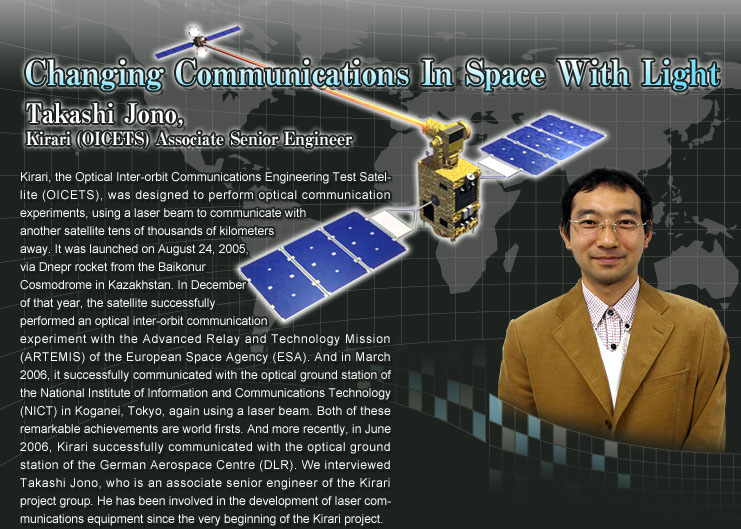|
Q. What is Kirari? mission?
 |
The Optical Inter-orbit Communications Engineering Test Satellite, Kirari
|
Kirari is a communications test satellite. It uses lasers to communicate with satellites that are tens of thousands of kilometers away.
On the ground, light is used to transmit data all the time, using fiber optics. But to transmit data from one satellite to another, or between a satellite and the ground, the only option we currently have is radio waves.
Kirari? mission is to see if we can do optical communication in space using laser beams. Compared to radio-wave communication, optical communication is faster, able to transmit more information, and requires smaller and lighter equipment. Using laser beams in space is easier than on the ground, because they don? have obstacles such as air and vapor. In space, they face barely any interference at all.
Q. What were some of the challenges of this project?
We had a tough time because no one had prior experience with inter-orbit laser communications. Developing technology to accurately control laser beam direction in space was especially difficult. With fiber optics, laser beams are transmitted directly into the cable. But the technology to accurately control a laser beam? direction in air had not yet been developed. There had been a number of experiments using an engineering test model, but in spite of that there were times we could not get the performance we needed, and we had to greatly revise the spacecraft design. Research and development for the Kirari/OICETS mission started in 1993, and by the time all the confirmation tests for the onboard laser communications equipment were completed, it was 2000.
Q. Could you describe the communication experiment with Europe? ARTEMIS in December 2005? Not only was the distance between Kirari and ARTEMIS about 40,000 kilometers, but both satellites were moving. What were the challenges?
 |
| Europe? Advanced Relay and Technology Mission (ARTEMIS) |
 |
Conceptual rendering of Kirari experiment
|
 |
The objectives of the experiment with ARTEMIS were advanced laser-beam acquisition and tracking, and bi-directional data communication. First, we succeeded in acquisition and tracking, and after many tests, on December 9, we finally succeeded in the world? first bi-directional optical inter-orbit communication.
Kirari is positioned in a low Earth orbit and is moving at about seven kilometers per second. ARTEMIS is a geostationary satellite, which means it appears to be stationary, but in fact it is traveling around the Earth at about three kilometers per second. So the speed at which the two satellites are passing each other is several kilometers per second. Kirari? beamwidth is 5 microradians [a microradian is about 1/10,000 of a degree], which is extremely small. So performing this experiment is a bit like throwing a basketball from Tokyo and hitting the top of Mt. Fuji ?except both Tokyo and Mt. Fuji are in motion. I hope this gives you an idea of how difficult and sophisticated the technology is: two satellites must be able to direct an ultra-thin beam towards each other, while both are moving at speeds of several kilometers per second.
Here? how the experiment worked. In order to be able to precisely target a laser beam between the two satellites, they first exchanged positioning information. Based on that information, each satellite calculated the other? position and speed, so that they were able to aim their own laser communications equipment according to the other satellite? motion. Then, ARTEMIS transmitted a beacon beam at the estimated position of Kirari, and Kirari, having received the beam, sent a laser beam back at ARTEMIS. Technically, ARTEMIS had only 5 minutes to send a beacon beam, which means that both satellites had to track each other within that limited time. It was absolutely new, and an incredibly difficult challenge for two satellites moving so fast to determine each other? location and acquire and track beams in such a short period of time. |
|

